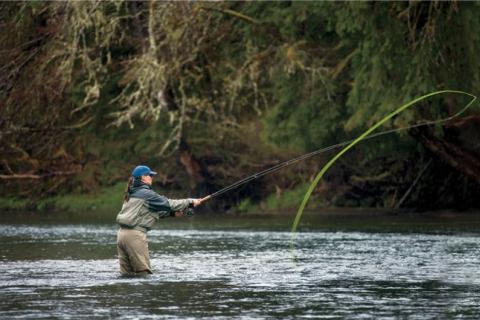
If you only have limited time to fish, such as weekends, then fishing in bad weather and rain is sometimes unavoidable. Personally I like fly fishing in the rain and have had several great days on the water, but understanding how the precipitation is going to effect the fish and flies makes all the difference in the world. While the wet conditions can be a bit of a downer on the spirit, the fishing can be as good as it gets.
 If you are thinking that fishing in the rain could be a possibility, you need to consider what is going to be your approach. Do you fish when there is a chance of rain, do you fish after the rain has passed or do you head out during the torrential downpour?
If you are thinking that fishing in the rain could be a possibility, you need to consider what is going to be your approach. Do you fish when there is a chance of rain, do you fish after the rain has passed or do you head out during the torrential downpour?
Types of Rain
Drizzle- This type of rain is when the moisture is light and/ or intermittent. Stick with you normal techniques and patterns. These light rain periods will not change the behavior of fish, their feeding habits, or hatches.
Steady Rain– This type of rain is when showers have been continuous (for greater than 1 hour). You should be able to still fish the river but will have to change how you are fishing because water levels will start to rise and the color will slowly be getting muddier. Fish will usually still be hanging around cover (rocks and logs) and will start to lose their desire to rise for dry flies.
Downpour- This type of rain is characterized by heavy downfall rain conditions that will flood/ muddy the river. Fishing in these conditions changes as ongoing dry fly fishing will slow as food items are being washed into the river and pulled below by the currents. Nymphs and worm patterns will produce well while heavy rains are raising the water, and streamers will produce as the clarity decreases.
1. When the Rain Starts
Heading out before the rain hits can be very productive. The period before the rain hits is usually great for all types of fly fishing, and even after the rain first starts you are still able to fish all the different types of flies from dries to nymphs.
To me it seems like that in the first hour or so of the rainfall (if it is not too heavy), fish really key in on the surface. Hoppers, beetles, worms and ants get swept from the banks, making easy meals for marauding trout. Since these land loving critters come in many shapes, sizes and colors, keeping a good supply of terrestrials on hand should keep you prepared for anything you might encounter. In the first few hours of rain don't be afraid of fishing on the surface; hatches will still go, and fish should lie in traditional stream reach areas.
2. As Rain Continues Switch Fishing Techniques
As the rain wears on and the water level either begins to rise or becomes partly stained, then switching techniques becomes important. Fish will slowly move from feeding on the surface to feeding on the bottom. I like nymphing with flashy beadhead patterns during this transition. Whether it is the shiny beadhead or the hot colors added to nymph patterns, it seems like these nymph patterns really get the trout's attention. Fish these flies with a high stick technique, getting as much line off the water as possible so that your flies can dead drift downstream.
3. After Rain Ends Change Fishing Techniques Again
Once the downpour has ended and the river is swollen and discolored, once again you should switch flies and techniques. This transition is best suited for big, dark colored aggressive streamer patterns. Not only do you want to pick a pattern that will stand out in the water (black or dark brown patterns produce a great silhouette in stained water), you want a fly that will disrupt the water letting fish know it is there. Beadhead bunny leeches or beadhead wooly buggers are a time-tested favorite in these conditions because of their size, weight and action on the water.
The rain does not always have to ruin your fishing plans if you understand how it affects the fish you are targeting. Get yourself good rain gear and enjoy a day on your favorite river or stream.
- 34804 views

